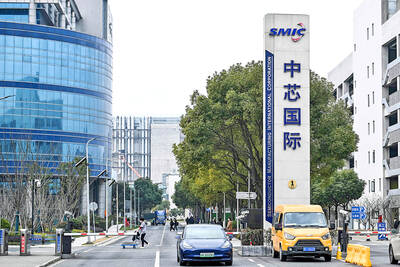Asian currencies had their biggest weekly drop in more than a month as demand for the US dollar rose on the widening interest-rate gap with the euro.
The Bloomberg-JPMorgan Asia Dollar Index fell 0.2 percent this week in the steepest drop since the period through Aug. 1. South Korea’s won and Malaysia’s ringgit led losses after an unexpected cut in the European Central Bank’s (ECB) benchmark rates. Improving US data are increasing the odds the US Federal Reserve will raise borrowing costs next year.
“The US dollar strength has spilled over in emerging Asian currencies,” said Jonathan Cavenagh, a Singapore-based foreign-exchange strategist at Westpac Banking Corp. “The strengthening US economy is creating expectations that US rates will rise sooner rather than later.”
The ringgit fell 1 percent this week to 3.1825 per US dollar in Kuuala Lumpur, data compiled by Bloomberg show. The won fell 1 percent to 1,024.25, Indonesia’s rupiah lost 0.5 percent to 11,755 and the Thai baht dropped 0.4 percent to 32.081. The Bloomberg Dollar Spot Index tracking the currency against 10 major peers touched a 13-month high.
In Taiwan, the NT dollar edged down 0.1 percent this week to NT$30.002.
The US dollar rose against the local currency on Friday, gaining NT$0.030 to close at the day’s high, as the central bank took advantage of the weakness of other regional currencies to push down the local unit at the end of the session, dealers said.
It was the first time the US dollar closed above the NT$30 mark since Aug. 26, when it ended at NT$30.026.
Market sentiment remained cautious ahead of the release of US non-farm payroll data scheduled for later in the day in the hopes of gaining a better understanding about the US economy, dealers said.
ECB President Mario Draghi lowered the benchmark refinancing and deposit rates on Thursday to 0.05 percent and minus-0.2 percent respectively, weakening the euro 1.6 percent in the biggest drop since November 2011.
US Fed Chair Janet Yellen told central bankers in Jackson Hole, Wyoming, last month that US policymakers might raise interest rates sooner than investors anticipate amid labor- market gains.
“The euro-dollar moved so much, obviously you will have a reaction in dollar-Asia,” said Andy Ji, a Singapore-based currency strategist at Commonwealth Bank of Australia. “Once the market digests the big euro-dollar move, next week we’ll see Asian currencies being supported.”
The won completed its biggest weekly loss in more than a month before the three-day Chuseok holiday starting Sept. 8.
“The globally strong [US] dollar triggered by the ECB meeting will affect the won,” said Park Daebong, a Seoul-based currency trader for Nonghyup Bank.
Elsewhere in Asia this week, the Philippine peso declined 0.1 percent to 43.662 per dollar, while China’s yuan strengthened 0.03 percent to 6.1412, India’s rupee rose 0.1 percent to 60.445 and the Vietnamese dong was steady at 21,195.
Draghi’s unprecedented easing policies also sent the euro on the longest weekly losing streak in the shared currency’s 15-year history. The European currency dropped 1.4 percent to US$1.2951 this week in New York trading and touched US$1.2920, the lowest level since July last year. The eight-week losing streak is the longest since the euro began trading in 1999.
The euro fell for a second week against the yen, declining 0.4 percent to ¥163.11.
The yen depreciated 1 percent to ¥105.09 and reached ¥105.71, the weakest level since October 2008.
Sterling was the biggest loser among the US currency’s 31 major counterparts. The pound dropped 1.6 percent to US$1.6327 as the Bank of England kept its policy rate unchanged at 0.5 percent and amid signs Scotland’s independence vote on Sept. 18 would be more closely contested than previously indicated.
The Australian dollar was the biggest winner, gaining 0.42 percent to US$0.9378.
The Bloomberg Dollar Spot Index rose for a third week, touching 1,041.58, the highest level since July last year.

SEMICONDUCTOR SERVICES: A company executive said that Taiwanese firms must think about how to participate in global supply chains and lift their competitiveness Taiwan Semiconductor Manufacturing Co (TSMC, 台積電) yesterday said it expects to launch its first multifunctional service center in Pingtung County in the middle of 2027, in a bid to foster a resilient high-tech facility construction ecosystem. TSMC broached the idea of creating a center two or three years ago when it started building new manufacturing capacity in the US and Japan, the company said. The center, dubbed an “ecosystem park,” would assist local manufacturing facility construction partners to upgrade their capabilities and secure more deals from other global chipmakers such as Intel Corp, Micron Technology Inc and Infineon Technologies AG, TSMC said. It

NO BREAKTHROUGH? More substantial ‘deliverables,’ such as tariff reductions, would likely be saved for a meeting between Trump and Xi later this year, a trade expert said China launched two probes targeting the US semiconductor sector on Saturday ahead of talks between the two nations in Spain this week on trade, national security and the ownership of social media platform TikTok. China’s Ministry of Commerce announced an anti-dumping investigation into certain analog integrated circuits (ICs) imported from the US. The investigation is to target some commodity interface ICs and gate driver ICs, which are commonly made by US companies such as Texas Instruments Inc and ON Semiconductor Corp. The ministry also announced an anti-discrimination probe into US measures against China’s chip sector. US measures such as export curbs and tariffs

The US on Friday penalized two Chinese firms that acquired US chipmaking equipment for China’s top chipmaker, Semiconductor Manufacturing International Corp (SMIC, 中芯國際), including them among 32 entities that were added to the US Department of Commerce’s restricted trade list, a US government posting showed. Twenty-three of the 32 are in China. GMC Semiconductor Technology (Wuxi) Co (吉姆西半導體科技) and Jicun Semiconductor Technology (Shanghai) Co (吉存半導體科技) were placed on the list, formally known as the Entity List, for acquiring equipment for SMIC Northern Integrated Circuit Manufacturing (Beijing) Corp (中芯北方積體電路) and Semiconductor Manufacturing International (Beijing) Corp (中芯北京), the US Federal Register posting said. The

India’s ban of online money-based games could drive addicts to unregulated apps and offshore platforms that pose new financial and social risks, fantasy-sports gaming experts say. Indian Prime Minister Narendra Modi’s government banned real-money online games late last month, citing financial losses and addiction, leading to a shutdown of many apps offering paid fantasy cricket, rummy and poker games. “Many will move to offshore platforms, because of the addictive nature — they will find alternate means to get that dopamine hit,” said Viren Hemrajani, a Mumbai-based fantasy cricket analyst. “It [also] leads to fraud and scams, because everything is now